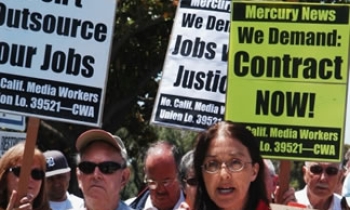US news organisations are under tremendous pressure to find radical new ways to make money as their financial outlooks worsen despite embracing new technology. One way to do it may be to charge Web users for news in a way they cannot avoid -- their Internet access bill, the “State of the News Media 2007” has said.

“The hope that Internet advertising will someday match what print and television now bring in appears to be vanishing,” according to the study, published by the Project for Excellence in Journalism (PEJ), a Washington-based nonprofit group affiliated to the Pew Charitable Trusts.
News outlets, particularly US newspapers, were able to rely on advertising and subscriptions for years, and staked hopes on online sales eventually eclipsing weaker print revenue. That may not eventually work out, said Tom Rosenstiel, the study’s supervisor and the group’s director. The amount of online advertising dollars is still rising, “but now there are growing doubts about how much of that will accrue to news.”
“The people on the countinghouse side have got to come up with a new plan,” said Rosenstiel, who covered the news business for the Los Angeles Times. “The audience is migrating but advertising probably never'll in sufficient amounts.”
With more people expecting news for free on the Internet, publishers may need to consider forming consortiums to charge for online news, the study said. “The increasingly logical scenario is not to charge the consumer directly,” it said.
“People haven’t lost interest in news,” said Rosenstiel. But all facets of the industry are hurting simply because there are so many more ways to get information — on broadcast and cable television, big-city newspapers and local handouts, websites, blogs, cellphones, and PDAs.
“The problem is more about capturing an audience that you can convert into money to subsidise the gathering of news,” Rosenstiel pointed out. Some newspapers have reacted to the diminished capacity by closing foreign bureaus or trying to play up local news. But these approaches may make these newspapers increasingly irrelevant in the eyes of readers, he said.

Rosenstiel said there have been many improvements in media-owned websites. Blogs are also starting to get more journalistic, counter to the image of someone sitting in their pajamas and writing what comes to them. He cited the LA Observed website and Global Voices, which culls news from various sources around the world and subjects it to tight editing. “Where we need to have bolder leadership is on the business side,” he said.
“The current thinking, hyper-localism, seems problematic,” Rosenstiel told LA times. “In an era of globalism, how can you suggest that the Los Angeles or Boston market does not need its own specialised foreign reporting that informs the local economy, the local culture and more, in a way that is different than what generic wires would cover?”
“Instead, news providers would charge Internet providers and aggregators licensing fees for content.” Rosenstiel acknowledged that this approach, similar to the cable television model, could result in more expensive Internet access bills. “It’s either that or journalism shrinks in America,” he asserted.
Figuring out how the news business will survive is the most pressing question on the minds of publishers as well as investors. But Wall Street’s patience is limited, and newspaper stocks have been falling steadily for several years.
Publishers are trying to cut expenses through layoffs, outsourcing and changing what they cover, even as they try to get more revenue through new technology and local coverage that they think will attract more advertisers.

This has led to the sale of several large papers to private buyers. Two US mainstay newspaper companies, Knight Ridder and Pulitzer, were swallowed up by rivals. A third, Tribune Co, is considering bids for all or parts of the company.
Longtime newspaper analyst John Morton toldReuters that newspapers must invest more in new technology. While most newspaper executives realize that, it has not proceeded as quickly as it should have, he said. “The newspaper business has always been a laggard on spending in research and development,” Morton said.
The good news for traditional media organisations, said Rosenstiel, is that they are finally recognising the challenges that have chipped away at the industry for years. The bad news, he said, is that they have few good answers for how to change their business model. The industry must find a visionary leader, he said, like cable news magnate Ted Turner, who foresaw the potential of cable television and translated it into CNN.
The report asked: “Does the industry have a vision that is bold enough and does it have leaders whom journalists and audiences will follow?”









